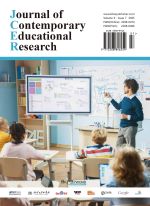Research on Teaching Reform in Environmental Design Courses Based on Virtual Simulation Technology
Abstract
Addressing limitations such as the lack of immersion and difficulties in comprehensively evaluating design schemes in traditional teaching models of environmental design courses, this study explores teaching reforms using virtual simulation technology. An immersive virtual teaching environment was constructed, integrating virtual simulation technology gradually into the teaching process, with practical teaching cases used to assess the effectiveness of these reforms. Results demonstrate that virtual simulation technology significantly enhances students’ spatial understanding and design expression abilities, while also improving teaching interactivity and student engagement. This reform aligns with the trend towards digital design, offering innovative ideas and methodologies for teaching environmental design courses.
References
Tan Y, Xu W, Li S, et al., 2022, Augmented and Virtual Reality (AR/VR) for Education and Training in the AEC Industry: A Systematic Review of Research and Applications. Buildings, 12(10): 1529. https://doi.org/10.3390/buildings12101529
Gong Q, Wu Y, Li H, 2023, Experimental Research on Virtual Simulation Teaching of Exhibition Design Based on Immersive Experience. Journal of Education, Humanities and Social Sciences, 9: 6452. https://doi.org/10.54097/ehss.v9i.6452
Díaz Gonzalez EM, Belaroussi R, Soto-Martín O, et al., 2025, Effect of Interactive Virtual Reality on the Teaching of Conceptual Design in Engineering and Architecture Fields. Applied Sciences, 15(8): 4205. https://doi.org/10.3390/app15084205
Zhang Y, Huang X, 2024, Integrating Extended Reality (XR) in Architectural Design Education: A Systematic Review and Case Study at Southeast University (China). Buildings, 14(12): 3954. https://doi.org/10.3390/buildings14123954
Agirachman FA, Shinozaki M, 2021, Design Evaluation in Architecture Education with an Affordance-Based Approach Utilizing Non-Virtual Reality and Virtual Reality Media. Technology | Architecture + Design, 5(2): 188–206. https://doi.org/10.1080/24751448.2021.1967059
Hou N, Nishina D, Sugita S, et al., 2024, Virtual Reality Space in Architectural Design Education: Learning Effect of Scale Feeling. Building and Environment, 244: 111060. https://doi.org/10.1016/j.buildenv.2023.111060
Serna-Mendiburu GM, Guerra-Tamez CR, 2024, Shaping the Future of Creative Education: The Transformative Power of VR in Art and Design Learning. Frontiers in Education, 9: 1388483. https://doi.org/10.3389/feduc.2024.1388483
Aydin S, Aktas B, 2020, Developing an Integrated VR Infrastructure in Architectural Design Education. Frontiers in Robotics and AI, 7: 495468. https://doi.org/10.3389/frobt.2020.495468

